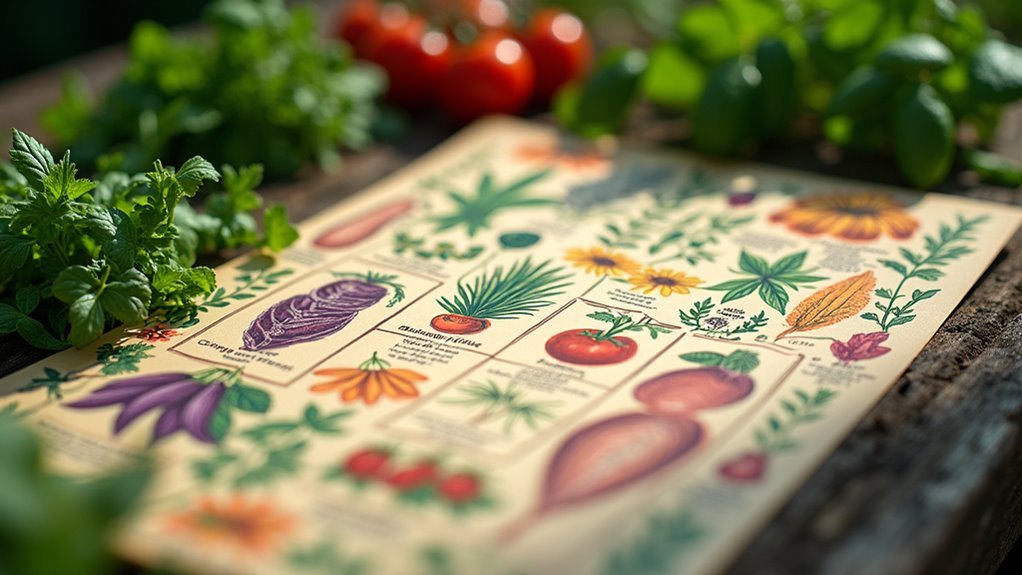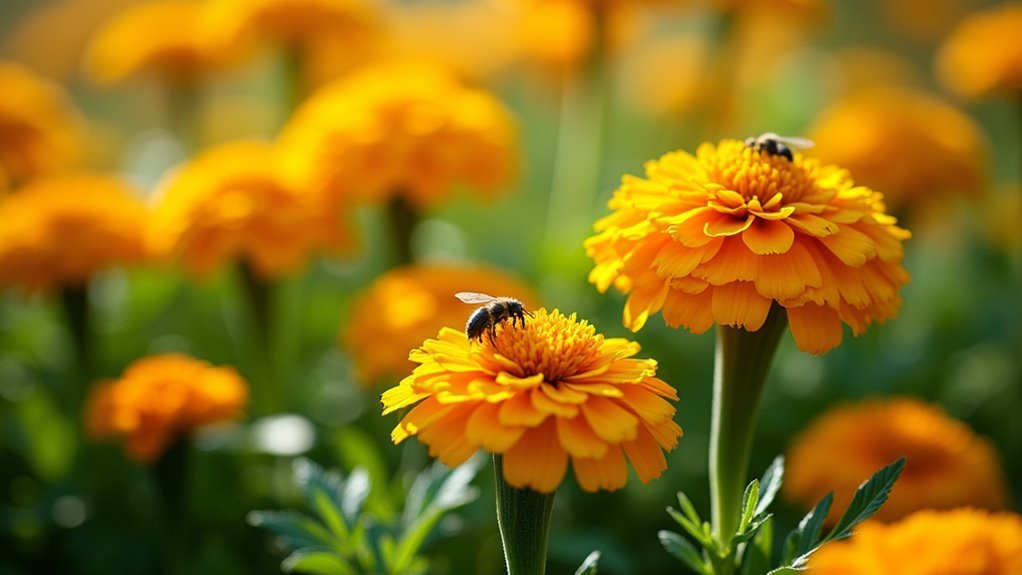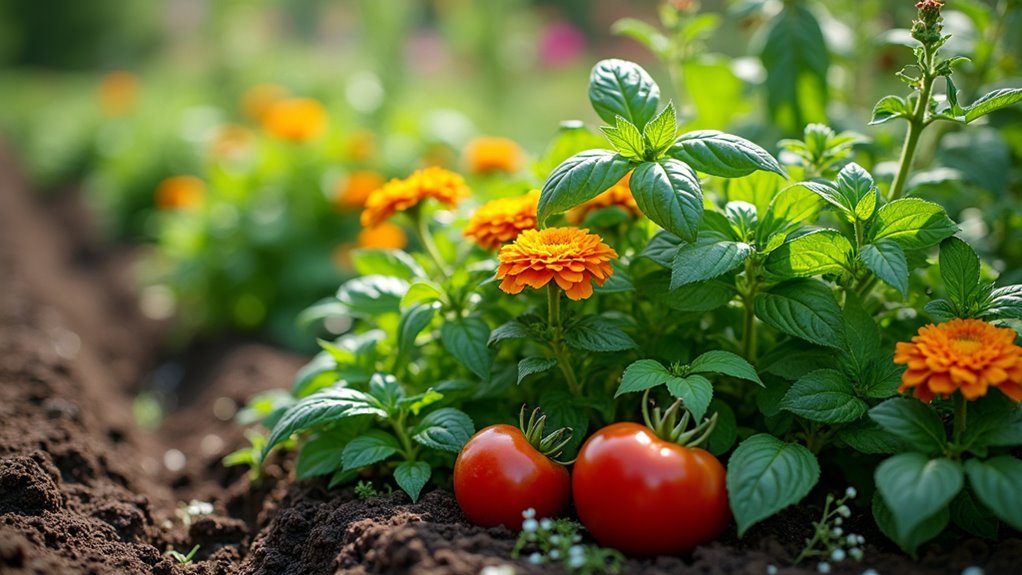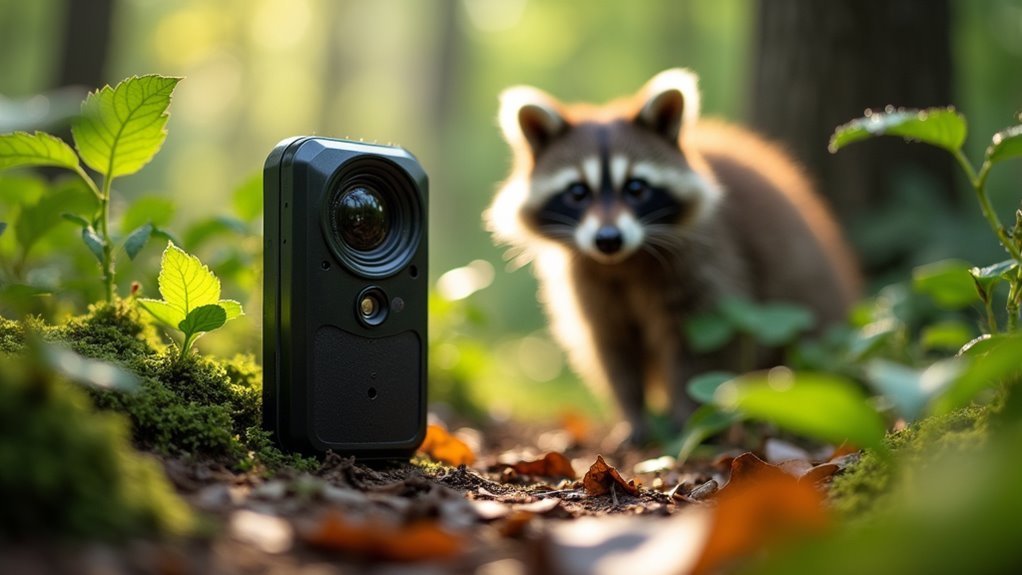Companion planting charts help you create a natural pest control system by strategically pairing plants that repel harmful insects and attract beneficial predators. You’ll discover how aromatic herbs like basil and rosemary deter specific pests, while marigolds and nasturtiums serve as protective barriers around vulnerable crops. These plant partnerships use chemical communication and diverse scents to confuse pest populations, reducing damage without pesticides. Below, you’ll find detailed charts and strategies to transform your garden into a self-sustaining ecosystem.
Understanding Companion Planting for Natural Pest Management

While chemical pesticides dominate conventional gardening, companion planting offers a natural alternative that harnesses the power of plant relationships to manage pests effectively.
You’ll discover that strategic companion planting combinations create a balanced ecosystem where plants work together for mutual protection. This organic pest control method relies on specific plants that naturally repel pests while simultaneously working to attract pollinators and beneficial insects to your garden.
When you implement natural pest management strategies, you’re creating diverse plantings that confuse pest populations and reduce damage.
Strongly scented herbs like basil and rosemary repel unwanted insects, while flowers such as nasturtiums and marigolds serve dual purposes.
You’ll find these plants deter specific pests while drawing in helpful predators, establishing sustainable garden health without chemical dependency.
The Science Behind Plant Partnerships and Pest Deterrence
When you plant companions together, you’re tapping into sophisticated chemical communication systems where plants release specific compounds that either repel harmful insects or signal distress to neighboring plants.
Your garden becomes a strategic ecosystem that attracts beneficial insects like ladybugs and parasitic wasps, which naturally control pest populations without chemicals.
You’ll also create confusion mechanisms that disrupt pest behavior, making it difficult for harmful insects to locate and damage their preferred host plants.
Chemical Communication Systems
Beneath the soil and above ground, your garden plants are constantly chatting through an intricate network of chemical signals that would make any social media platform jealous. When pests attack, stressed plants release volatile organic compounds that alert neighboring plants to activate their defense systems. These chemical signals also attract beneficial predatory insects that naturally control pest populations.
| Signal Type | Garden Benefit |
|---|---|
| Alarm VOCs | Warns nearby plants of threats |
| Attractant compounds | Draws helpful predator insects |
| Repellent chemicals | Deters harmful pests directly |
| Growth inhibitors | Reduces weed competition |
Through companion planting, you’re fundamentally creating a botanical neighborhood watch. Plants like marigolds release compounds that repel nematodes, while others enhance pest resistance in neighboring crops by boosting production of protective flavonoids and terpenes.
Beneficial Insect Attraction
As your plants send out their chemical dinner invitations, they’re fundamentally rolling out the red carpet for nature’s most effective pest control squad.
When you implement companion planting strategies, you’re creating diverse habitats that attract beneficial insects while naturally deterring harmful pests through organic gardening methods.
Strategic plant partnerships work exceptionally well:
- Aromatic herbs like dill and fennel emit fragrances that attract parasitic wasps and hoverflies, which actively hunt aphids and caterpillars.
- Flowering companions such as marigolds provide essential nectar and pollen for beneficial insects while boosting pollination rates.
- Trap crops like nasturtiums draw pests away from valuable crops while simultaneously attracting their natural predators.
This diverse ecosystem confuses pests, making it harder for them to locate host plants while supporting the beneficial insects that’ll repel unwanted garden visitors.
Pest Confusion Mechanisms
While pests navigate your garden using sophisticated sensory systems, companion planting creates a complex web of confusion that disrupts their hunting strategies.
You’re fundamentally jamming their radar by mixing diverse plant scents and visual cues throughout your garden space.
Aromatic herbs like basil, rosemary, and marigolds mask scent trails that pests use to locate their preferred host plants.
When you interplant these fragrant companions with vulnerable crops, you’re creating olfactory chaos that leaves insects disoriented and unable to zero in on their targets.
These pest confusion mechanisms work synergistically with beneficial insects, who aren’t affected by the same disruption patterns.
The volatile organic compounds released by companion plants effectively reduce pest populations while maintaining ecological balance, giving you natural protection without harmful chemicals.
Essential Companion Plants for Organic Pest Control
You’ll find that certain plants act as natural bodyguards for your garden, repelling harmful insects while simultaneously rolling out the welcome mat for beneficial pollinators.
Marigolds and nasturtiums stand out as powerhouse companions that’ll keep pests at bay while adding vibrant color to your growing space.
These strategic plantings create a living defense system that protects your crops without relying on chemical interventions.
Natural Pest Deterrent Plants
When designing an organic garden, certain companion plants act as powerful natural guardians that protect your crops without harsh chemicals.
These strategic plantings offer effective natural pest control while supporting your garden’s ecosystem.
Smart organic gardener choices include these proven deterrent plants:
- Aromatic herbs – Basil repels potato bugs and flies around tomatoes, while rosemary’s strong scent deters carrot flies and bean beetles.
- Flowering companions – Marigolds repel pests like aphids and cabbage moths while attracting beneficial insects for pollination.
- Strategic barriers – Mint effectively controls aphids and spider mites, while chives attract helpful pollinators when flowering.
These companion plants create a defensive network that naturally repel pests without compromising soil health or beneficial insects, making them essential components of sustainable gardening practices.
Beneficial Insect Attractors
Beyond repelling harmful pests, the most effective companion plants actively draw beneficial insects that become your garden’s natural pest management team.
| Plant | Beneficial Insects Attracted | Pest Control Benefits |
|---|---|---|
| Marigolds | Ladybugs, hoverflies | Controls aphids, whiteflies |
| Sweet Alyssum | Parasitic wasps, lacewings | Manages caterpillars, aphids |
| Zinnias | Predatory beetles, spiders | Reduces thrips, cucumber beetles |
| Nasturtiums | Hoverflies, ground beetles | Controls aphids, squash bugs |
When you’re planting herbs and flowers that attract beneficial insects, you’ll create a balanced ecosystem that naturally manages pest issues. Basil attracts beneficial insects while repelling flies, making it perfect near tomatoes. Rosemary invites predatory insects that eliminate carrot flies and bean beetles. These companion plants work continuously, providing nectar sources that keep your garden’s beneficial insect population thriving year-round.
Nasturtiums: The Ultimate Trap Crop for Garden Protection

While many gardeners struggle with aphids and other destructive pests, nasturtiums offer a brilliant solution by acting as sacrificial plants that lure these insects away from your prized vegetables.
These versatile trap crops provide continuous protection from spring through fall, making them essential for effective companion planting strategies.
You’ll maximize nasturtiums’ pest control benefits by following these key practices:
- Plant near vulnerable crops – Position nasturtiums alongside carrots, broccoli, and tomatoes for ideal protection.
- Utilize multiple growing spaces – Grow them in vegetable beds, flower borders, or containers throughout your garden.
- Harvest edible flowers regularly – Pick the peppery blooms for culinary use while maintaining plant vigor.
This dual-purpose approach combines practical pest management with beneficial insects attraction and fresh ingredients for your kitchen.
Aromatic Herbs That Repel Common Garden Pests
Although chemical pesticides promise quick results, aromatic herbs provide a safer and more sustainable approach to pest control that transforms your garden into a naturally protected ecosystem.
These aromatic herbs repel pests while adding culinary value to your harvest. Plant basil near tomatoes to deter potato bugs and flies while enhancing flavor.
Rosemary’s strong scent repels carrot flies and bean beetles, making it perfect companion planting with cabbage and strawberries.
Contain mint in pots to control aphids and spider mites without spreading aggressively.
Sage effectively protects brassicas from white cabbage moths.
Chives repel destructive nematodes and attract beneficial insects when flowering.
This organic pest control strategy lets you grow plants together harmoniously.
Marigolds and Flower Power Against Harmful Insects

You’ll discover that marigolds pack serious pest-repelling power through their distinctive scent, which confuses and deters harmful insects like bean beetles, aphids, and cabbage moths.
These vibrant flowers work as natural bodyguards for your vegetables, creating an effective companion planting strategy that reduces your reliance on chemical pesticides.
When you plant marigolds strategically throughout your garden, you’re not just adding beautiful blooms—you’re building a natural defense system that protects your crops while attracting beneficial insects.
Marigold Pest Repelling Properties
When you plant marigolds in your garden, you’re harnessing one of nature’s most effective pest control systems.
These vibrant flowers emit strong scents that naturally repel pests like bean beetles, aphids, and cabbage moths while attracting beneficial insects such as pollinators and predatory bugs.
Marigolds excel in companion planting through three key mechanisms:
- Direct repellent action – Their powerful scent creates a protective barrier around vulnerable crops.
- Trap crops functionality – They lure harmful insects away from your valuable vegetables.
- Beneficial insect habitat – Their colorful blooms attract helpful predators that control pest populations.
Plant marigolds alongside cucumbers, potatoes, beans, and peas to greatly reduce infestations and boost yields.
You’ll enjoy both enhanced garden beauty and superior organic pest management.
Companion Planting Flower Strategies
Marigolds form the foundation of a powerful flower-based defense system, but they’re just one piece of a thorough companion planting strategy.
You’ll maximize your vegetable gardens’ protection by combining marigolds with other flowering companion plants like nasturtiums to create an impenetrable barrier against harmful insects.
This multi-flower approach works because different blooms target various pests while attracting beneficial pollinators that boost crop yields.
Plant marigolds alongside cucumbers, potatoes, beans, and peas as your primary pest deterrent, then add complementary flowers to fill any defensive gaps.
Your companion planting chart should include flowers that release soil compounds inhibiting nematodes while providing visual appeal.
This strategic flower placement transforms your garden into a self-sustaining ecosystem where beauty meets function, delivering natural pest control without chemicals.
Creating Beneficial Insect Habitats Through Plant Diversity
Since beneficial insects form the backbone of natural pest control, creating diverse plant habitats becomes essential for maintaining a thriving garden ecosystem.
Plant diversity provides food sources, shelter, and breeding grounds that foster balanced environments where beneficial insects can thrive and manage pest populations naturally.
Diverse plant habitats create natural sanctuaries where beneficial insects flourish, establishing self-regulating ecosystems that control pests without chemical intervention.
You’ll achieve effective pest management by implementing these strategic approaches:
- Plant flowering plants like cosmos and sweet alyssum to attract crucial pollinators and predatory insects that control harmful pests.
- Incorporate aromatic herbs such as mint and rosemary whose strong scents confuse and deter destructive insects from locating host plants.
- Include trap crops like nasturtiums that lure pests away from valuable plants while attracting beneficial insects that feed on these pests.
This approach reduces chemical dependency while encouraging sustainable garden management.
The Three Sisters Method: Traditional Companion Planting Wisdom
Among the most ingenious examples of companion planting, the Three Sisters method demonstrates how traditional agricultural wisdom can transform your garden into a self-sustaining ecosystem. This Native American technique combines corn, beans, and squash in a symbiotic relationship that maximizes space and resources.
You’ll find corn serves as natural support for climbing beans, eliminating the need for poles or trellises. Meanwhile, beans enrich soil fertility by fixing nitrogen, directly benefiting both corn and squash growth.
The squash completes this trio by acting as living mulch, reducing moisture loss and suppressing weeds naturally.
This cooperative gardening approach showcases sustainable agriculture at its finest. Each plant contributes unique benefits while receiving support from its companions, creating a productive ecosystem that’s both efficient and environmentally friendly.
Companion Planting Charts for Popular Vegetables
Twelve essential vegetable pairings can transform your garden’s productivity and pest resistance through strategic companion planting.
These proven plant pairings create organic solutions that naturally repel pests while attracting beneficial insects and pollinators to your garden.
Strategic companion planting delivers natural pest control and pollinator attraction through time-tested organic gardening methods that boost overall plant health.
Top Companion Plants for Popular Vegetables:
- Companion Plants for Tomatoes – Basil improves flavor while deterring flies and mosquitoes, creating effective pest control through aromatic compounds.
- Cucumber Protection – Nasturtiums and dill work together to repel cucumber beetles while drawing helpful predatory insects that eliminate harmful pests.
- Marigold Magic – These vibrant flowers serve as guardian plants for potatoes, beans, and peas, repelling aphids and cabbage moths while simultaneously attracting essential pollinators.
Garlic planted near cabbages and carrots provides additional protection against root maggots and caterpillars.
Strategic Plant Placement for Maximum Pest Control
While random plant placement might seem easier, strategic positioning transforms your companion planting efforts into a powerful pest management system.
Create natural barriers by placing pest-repelling plants like marigolds and nasturtiums around your garden’s perimeter. You’ll maximize pest control by interplanting fragrant herbs such as basil and rosemary near vulnerable crops, effectively masking their scent from invading insects.
Utilize vertical space by pairing climbing beans with corn—you’ll save ground space while promoting nitrogen enrichment.
Group plant companions with similar water and light requirements to optimize growing conditions.
Implement layered planting strategies where taller plants like sunflowers provide shade for shorter crops, reducing moisture loss and creating microclimates that deter pests while attracting beneficial insects to your garden ecosystem.
Combining Companion Planting With Other Organic Methods
Strategic placement sets the foundation, but you’ll achieve even greater results when you combine companion planting with other organic methods.
This integrated approach creates multiple layers of pest control that work synergistically.
Here are three powerful combinations to maximize your garden’s protection:
- Homemade repellents with diverse plant species – Spray garlic or hot pepper infusions on plants while maintaining varied companion planting arrangements to naturally deter insects.
- Beneficial nematodes alongside companion combinations – Release these soil warriors to target harmful pests underground while your companion plants protect above ground, ensuring beneficial insects remain safe.
- Trap crops with physical barriers – Plant nasturtiums to attract aphids away from valuable crops, then use floating row covers strategically to prevent pest access while allowing beneficial insects garden entry.
Building Your Pest-Resistant Garden Ecosystem
Although combining companion planting with organic methods provides excellent results, you’ll create an even more powerful defense system when you focus on building a complete pest-resistant ecosystem.
Your garden ecosystem thrives when you strategically select compatible plants that naturally work together. Marigolds and nasturtiums don’t just repel pests—they actively attract beneficial insects like ladybugs and lacewings that hunt harmful invaders.
Incorporating a diversity of plants confuses pests by disrupting their ability to locate host plants through varied scents and colors.
Strong-scented herbs like basil and rosemary serve double duty in your pest control strategy, repelling specific insects while encouraging predatory species.
This balanced approach through companion planting improves soil health, reduces chemical dependency, and creates lasting resilience against future pest invasions.
Frequently Asked Questions
What Companion Plants Keep Pests Away?
You’ll find nasturtiums repel aphids and squash bugs, while basil deters potato bugs near tomatoes. Marigolds keep bean beetles away, rosemary stops carrot flies, and chives repel nematodes while attracting beneficial insects.
What Plant Works as a Natural Pest Control?
You’ll find marigolds work exceptionally well as natural pest control. They emit strong scents that repel bean beetles, aphids, and other harmful insects while attracting beneficial pollinators to your garden.
What Is the Best Organic Pest Control?
You’ll find companion planting delivers the best organic pest control by strategically pairing plants like marigolds with vegetables. This method naturally repels pests while attracting beneficial insects, creating sustainable garden ecosystems.
Which Vegetables Should Not Be Planted Next to Each Other?
You shouldn’t plant tomatoes near potatoes, beans next to onions, cabbage with strawberries, carrots alongside dill, or corn close to tomatoes. These combinations can stunt growth, attract harmful pests, or reduce yields considerably.
In Summary
You’ve now got the tools to create a naturally pest-resistant garden through strategic companion planting. Start small with one or two proven partnerships, then expand your system as you gain confidence. Remember, you’re building an ecosystem that takes time to establish. Don’t expect overnight results, but stay consistent with your plantings. Your patience will reward you with a thriving, chemical-free garden that manages pests naturally while producing healthier crops.





Leave a Reply